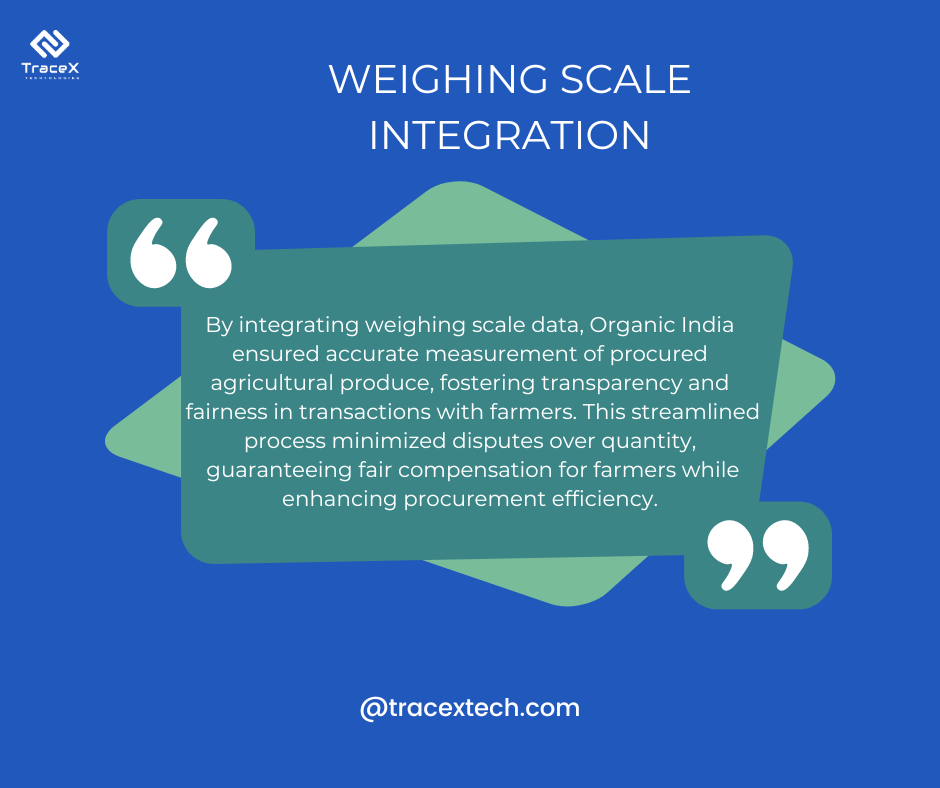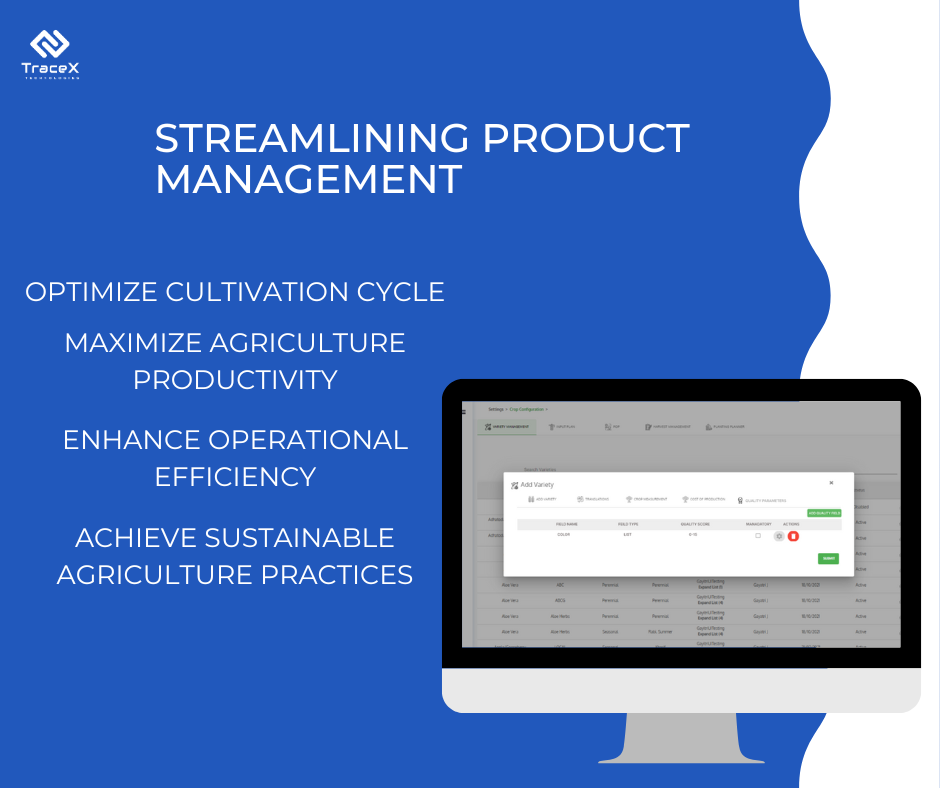Contact: +91 99725 24322 |
Menu
Menu
Quick summary: Learn how TraceX's robust product management features streamline agricultural supply chains, ensuring transparency, compliance, and traceability from farm to fork. Explore the benefits of centralized product information and configuration in our latest blog.

Product management in agricultural supply chains refers to the systematic approach of organizing, categorizing, and managing various agricultural products throughout their lifecycle, from production to consumption. It involves the comprehensive management of product information, attributes, and certifications to ensure compliance with regulatory standards, meet consumer expectations, and optimize supply chain efficiency.
Amidst the rising global demand for food, farmers are under greater pressure to enhance their operations and yield potential. This underscores the significance of product management strategies in agriculture.
In the era of data-driven and technology-enabled agriculture, the application of product management principles has become increasingly crucial for boosting efficiency and productivity.
Centralized product information and configuration play a crucial role in facilitating traceability and compliance within agricultural supply chains. By centralizing product data in a unified repository, stakeholders can access accurate and up-to-date information about each product, including its origin, attributes, quality grades, and certifications. This centralized approach streamlines data management processes and eliminates information silos, ensuring consistency and reliability across the supply chain. Furthermore, centralized product configuration allows for the standardized categorization and classification of agricultural products based on various attributes such as organic or conventional status, geographical origin, and quality standards. This standardized approach enhances traceability by providing clear visibility into the characteristics and properties of each product, enabling stakeholders to track its journey from farm to fork.
Moreover, centralized product information and configuration are essential for ensuring compliance with regulatory requirements and industry standards. By maintaining accurate records of product attributes and certifications, agricultural stakeholders can demonstrate compliance with food safety regulations, sustainability certifications, and labeling requirements. This not only mitigates the risk of non-compliance but also enhances transparency and trust among consumers and regulatory authorities.
Agribusinesses face several challenges that underscore the necessity of product management.
Diverse Product Portfolio:
Agribusinesses often deal with a wide range of products, including various crops, livestock, and inputs such as fertilizers and pesticides. Managing this diverse portfolio efficiently requires robust product management capabilities.
Product Master Feature
The product master in TraceX serves as a pivotal component in maintaining a centralized repository of product information within agricultural supply chains. At its core, the product master functions as a comprehensive database that stores and organizes critical details about various agricultural products, ranging from seeds and crops to livestock and processed goods.
One of the key roles of the product master is to consolidate and standardize product information from multiple sources into a single, unified platform. This includes essential details such as product names, descriptions, unique identifiers, origin, attributes, certifications, and quality standards. By centralizing this information, the product master ensures data consistency, accuracy, and accessibility across the entire supply chain ecosystem.
Having a centralized repository for managing product details offers numerous benefits for agricultural stakeholders.
Discover how a leading exporter of fruits and vegetables optimized their post-harvest management with TraceX’s product management features.
Explore the customer story now!
Supply Chain Complexity:
Agribusiness supply chains are complex, involving multiple stakeholders such as farmers, distributors, retailers, and consumers. Effective product management is essential for optimizing supply chain operations, ensuring traceability, and meeting customer demands.
Product Configuration Feature
Product configuration within TraceX offers a dynamic mechanism for customizing product attributes according to the specific requirements of agricultural supply chains. This functionality empowers stakeholders to define and manage a wide range of product characteristics, allowing for greater flexibility and adaptability in meeting diverse market demands and regulatory standards.
At its core, product configuration enables users to tailor key attributes of agricultural products based on various parameters such as cultivation methods, quality standards, certifications, and labeling requirements. For example, stakeholders can designate whether a particular product is classified as organic or conventional, reflecting the farming practices employed in its production. This distinction is essential for ensuring transparency and compliance with regulatory guidelines, as organic products may be subject to different certification criteria and labeling regulations compared to conventional counterparts.
One of the key features of production management in TraceX is comprehensive planning tools that enable users to strategize and schedule cultivation activities effectively. Through intuitive interfaces and customizable planning modules, farmers can create detailed cultivation plans based on factors such as crop type, planting season, and resource availability. These plans serve as roadmaps for optimizing resource allocation, minimizing downtime, and maximizing yield potential throughout the growing season.
Furthermore, TraceX facilitates seamless coordination and collaboration among stakeholders involved in the cultivation process. By providing centralized platforms for communication, task assignment, and progress tracking, TraceX enables real-time collaboration between farmers, agronomists, and field workers. This collaborative approach fosters transparency, accountability, and agility, ensuring that cultivation activities proceed smoothly and according to plan.
Regulatory Compliance:
The agricultural sector is subject to numerous regulations related to product safety, environmental protection, and labeling requirements. Ensuring compliance with these regulations necessitates meticulous tracking and management of product information.
Compliance with GS1
Ensuring compliance with Global Standards for Item Identification (GSI) is paramount in modern supply chain management, particularly within the context of agricultural trade. At the core of GSI compliance lies the Global Trade Item Number (GTIN), a unique identifier assigned to products to facilitate their identification and tracking across global markets. GTINs play a crucial role in streamlining supply chain operations, enabling seamless inventory management, accurate product labeling, and efficient exchange of information between trading partners. In the agricultural sector, where products traverse international borders and undergo various stages of processing and distribution, the adoption of GTINs is essential for enhancing transparency, traceability, and interoperability within the supply chain. By assigning a standardized GTIN to each product, stakeholders can establish a common language for product identification, ensuring consistency and accuracy in data exchange across diverse trading networks.
TraceX facilitates GSI compliance by offering robust GTIN generation capabilities that adhere to industry standards and best practices. Leveraging advanced algorithms and data management protocols, TraceX automatically assigns GTINs to products based on predefined criteria such as product category, packaging format, and geographical origin. This automated process ensures the generation of unique and globally recognized identifiers that comply with GSI requirements, eliminating the risk of duplicate or inconsistent identification.
Furthermore, TraceX integrates GTIN generation seamlessly into its product management framework, enabling users to associate GTINs with relevant product records and attributes. This linkage ensures that GTINs are accurately recorded and maintained throughout the product lifecycle, from production and packaging to distribution and retailing. By centralizing GTIN assignment within TraceX, stakeholders can streamline compliance efforts, reduce administrative overhead, and enhance data integrity across the supply chain.
Seasonal Variability:
Agricultural production is highly dependent on seasonal factors such as weather conditions, pest outbreaks, and market demand fluctuations. Product management tools can help agribusinesses anticipate and adapt to these seasonal variations more effectively.
Configurable Attributes
Beyond the organic-conventional dichotomy, product configuration in TraceX encompasses a multitude of configurable attributes that span the entire spectrum of agricultural products. These may include factors such as geographical origin, production methods (e.g., sustainable farming practices, fair trade certifications), genetic traits (e.g., non-GMO, heirloom varieties), processing techniques (e.g., raw, processed, value-added), and quality grades (e.g., grade A, premium quality).
By offering granular control over product attributes, TraceX enables stakeholders to accurately capture and communicate the unique characteristics of each product within the supply chain. This not only facilitates effective inventory management, pricing strategies, and marketing initiatives but also enhances transparency and trust among consumers who increasingly seek information about the provenance, quality, and sustainability of the products they purchase.
Market Competition:
In today’s competitive market, agribusinesses must differentiate their products, meet evolving consumer preferences, and maintain high-quality standards. Product management should enable businesses to innovate, analyze market trends, and tailor their offerings to meet customer needs.
Data Driven Insights with Technology and Integration
In addition to planning and coordination, TraceX offers advanced monitoring and analytics capabilities that empower users to track and analyze key performance indicators (KPIs) related to crop growth, health, and productivity. By collecting and analyzing data from various sources such as IoT sensors, weather forecasts, and field observations, TraceX provides valuable insights into crop performance and environmental conditions. These insights enable farmers to make data-driven decisions, identify potential risks or issues early, and implement timely interventions to optimize crop outcomes.
Moreover, TraceX facilitates seamless integration with farm machinery and equipment, enabling automated workflows and precision agriculture techniques. By connecting with IoT-enabled devices and agricultural machinery, TraceX enables tasks such as irrigation, fertilization, and pest control to be executed with precision and efficiency. This integration not only reduces manual labor and operational costs but also minimizes resource wastage and environmental impact.
Weighing scale integration in procurement processes enhances accuracy, transparency, and efficiency, ultimately contributing to the success and sustainability of agribusiness operations

Inefficient Planning and Resource Utilization by farmers
Manual methods for scheduling planting activities lack precision and may not account for crucial factors such as soil conditions, weather forecasts, and market demand. Additionally, inadequate inventory management of seeds can result in disruptions to planting schedules and compromised crop yields due to the unavailability of high-quality seeds when needed.
Streamlined Processes and Resource Utilization
Planning and planting are critical phases in the agricultural cycle, dictating the success and productivity of crop cultivation. With TraceX, farmers gain access to a suite of tools and functionalities designed to streamline these essential activities, thereby optimizing resource utilization and enhancing overall efficiency. One of the key features offered by TraceX is advanced planning capabilities, allowing farmers to meticulously schedule planting activities based on various factors such as crop variety, soil conditions, weather forecasts, and market demand. By leveraging historical data and predictive analytics, farmers can make informed decisions regarding the timing and placement of crops, maximizing yield potential while minimizing risks associated with adverse weather or pest outbreaks.
Additionally, TraceX provides comprehensive inventory management functionality, enabling farmers to efficiently manage their seed inventory throughout the planting season. Farmers can track seed quantities, monitor seed viability, and schedule seed procurement activities to ensure a steady supply of high-quality seeds for planting. Moreover, TraceX offers tools for seed treatment management, allowing farmers to apply necessary treatments such as seed coating or inoculation to enhance germination rates and crop health.
Limited visibility in Monitoring Crop Growth and Development
In traditional agricultural practices, farmers often struggle with limited visibility and timely monitoring of crop growth and development, leading to challenges in identifying and addressing potential issues that may affect crop health and yield.
Real-Time monitoring of Crop Growth
TraceX offers robust features for real-time monitoring of crop growth and development, providing farmers with invaluable insights into the health and progress of their crops throughout the cultivation cycle. Through the platform’s integration with IoT sensors, satellite imagery, and weather data, farmers can continuously monitor key parameters such as soil moisture levels, temperature, humidity, and crop health metrics. This real-time monitoring capability allows farmers to detect early signs of stress, disease, or nutrient deficiencies, enabling timely intervention and preventive measures to safeguard crop yield and quality. Additionally, TraceX provides visualizations and analytics tools that enable farmers to track crop growth trends over time, facilitating informed decision-making and strategic planning for optimal crop management.
Inaccuracies in Harvesting and Yield Management
In traditional agricultural practices, farmers often face challenges in effectively managing harvesting activities and optimizing yield due to manual record-keeping methods and limited visibility into critical harvest data. The lack of comprehensive tools and functionalities tailored to their specific needs hinders farmers’ ability to accurately track harvest units, record essential information such as harvest dates and quantities, and analyze harvest data to identify trends and make informed decisions.
Harvest Management
TraceX simplifies harvesting activities and enhances yield management by providing farmers with comprehensive tools and functionalities tailored to their specific needs. The platform enables farmers to efficiently manage harvest units, track harvest data, and optimize yield through a user-friendly interface. Farmers can record critical information such as harvest dates, quantities, quality parameters, and storage locations directly within the system, ensuring accurate and reliable data collection throughout the harvesting process. Moreover, the platform offers advanced analytics capabilities that enable farmers to analyze harvest data, identify trends, and make data-driven decisions to improve overall yield and profitability. By streamlining harvesting and yield management activities, it empowers farmers to maximize productivity, minimize losses, and achieve greater efficiency in their agricultural operations.

TraceX plays a pivotal role in improving traceability and transparency in product management within the agricultural supply chain. By centralizing product information and configuration data, TraceX enables users to create a comprehensive digital trail that traces the journey of agricultural products from farm to fork. The platform’s robust traceability features allow users to track product movement, monitor inventory levels, and trace the origin of products back to their source with unparalleled accuracy.
The platform provides farmers and agricultural stakeholders with a suite of features designed to conduct rigorous quality checks, adhere to regulatory standards, and generate compliance reports seamlessly. The platform allows for the recording of key quality parameters such as moisture levels, pH levels, chemical residues, and physical characteristics, enabling users to monitor product quality and ensure adherence to industry standards.
Moreover, the solution enhances transparency by providing stakeholders with real-time visibility into product attributes, production processes, and supply chain activities. By accessing centralized product information within the platform, users can gain valuable insights into product provenance, quality certifications, and sustainability attributes. This transparency not only fosters trust among consumers but also enables businesses to demonstrate their commitment to ethical sourcing, environmental stewardship, and regulatory compliance. Ultimately, it empowers agricultural stakeholders to build more transparent and resilient supply chains while meeting the evolving demands of consumers and regulatory authorities.
In conclusion, product management with TraceX revolutionizes the way agricultural supply chains operate by offering a comprehensive suite of tools and functionalities tailored to meet the diverse needs of farmers and stakeholders. From centralized product information and configuration to compliance checks, quality assurance, and enhanced traceability, it empowers users to optimize their operations, improve efficiency, and ensure compliance with regulatory standards. By leveraging cutting-edge technology and innovative solutions, the platform not only streamlines product management processes but also enhances transparency, traceability, and sustainability across the entire supply chain.
So enterprises out there, confidently navigate the complexities of product management, drive productivity, and pave the way for a more efficient and sustainable future in agriculture.
